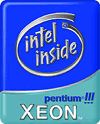Intel Developer Forum Conference - Spring 2001: Part 1
by Anand Lal Shimpi on March 5, 2001 12:00 PM EST- Posted in
- Trade Shows
Intel in the Server Market
The Intel Xeon processor is still due to be launched in the second quarter of this year in dual processor systems. Multiprocessor systems will follow later this year.
The Intel Xeon will debut at 1.4GHz with higher speed grades following later on. It will also be quite complementary to the current Intel Pentium III Xeon parts since they have already gained quite a bit of market share.
The Intel Xeon will probably be the first workstation/server class processor to use the microPGA form factor. The Intel Xeon's interface will be known as the mPGA600. So although the processor will actually have more pins than the Pentium 4 (600 vs 423), the pins will actually take up less space since they are positioned closer together (hence the name microPinGridArray).
 The microPGA chip form factor will later be introduced on the Northwood, the
0.13-micron Pentium 4 as the mPGA478.
The microPGA chip form factor will later be introduced on the Northwood, the
0.13-micron Pentium 4 as the mPGA478.
Shipping this quarter to extend Intel's presence in the server market is a "large cache" version of the Pentium III Xeon running at 900MHz. The "large cache" denotes a 2MB L2 cache (on-die), making this the largest processor core Intel manufactures.
In terms of market share, Intel presented some very interesting figures at this IDF regarding the distribution of the server market:

As you can see and as you would expect, the largest slice of the server pie is the 1-2 processor server segment. However the profit margins grow much higher as you move to 4 and 8+ way servers, making Intel's interest in those markets equally as great if not more. How popular is Intel in the server market?
|
Intel's Share of the Server
Markets
|
|
 |
 |
 |
|
With very little competition on a price to performance basis in the 1-2 way server market, Intel clearly holds the higher ground there. However moving forward, AMD will be entering into this very market, which could compromise Intel's 84% current market share. We would expect the transition in the 1-2 way server market to reflect that of the desktop CPU market, provided that the AMD 760MP proves to be a reliable SMP solution. While AMD won't take the entire market, they will definitely take their cut of the pie.
The 4-way server market is still amazingly Intel oriented. If you think about it, this is all attributed to the segmentation of Intel's product lines with the Pentium Pro and the following introduction of the Pentium II Xeon no more than 3 years ago. The Pentium II Xeon wasn't too difficult for Intel to develop; it was simply a larger cache version of the desktop Pentium II with a few other server-oriented features. Yet that very product translated into Intel taking a huge portion of the 4-way server market.
The new Intel Xeon based on the Foster core will most definitely contribute to the continued success of Intel in this market especially, where they won't face any competition for AMD for at least a little while.
The real surprise comes in the 8-way server market where Intel doesn't even have 50% market share. This segment is dominated by the Suns of the world and will take quite a bit of work for Intel to truly make an impact here. The Intel Xeon won't have any business selling itself here, as this is truly Itanium (IA-64) territory. The success of the Itanium will be directly reflected in Intel's market share in this segment. The 8-way server market offers the highest profit margins so Intel is definitely very interested in this particular segment.










2 Comments
View All Comments